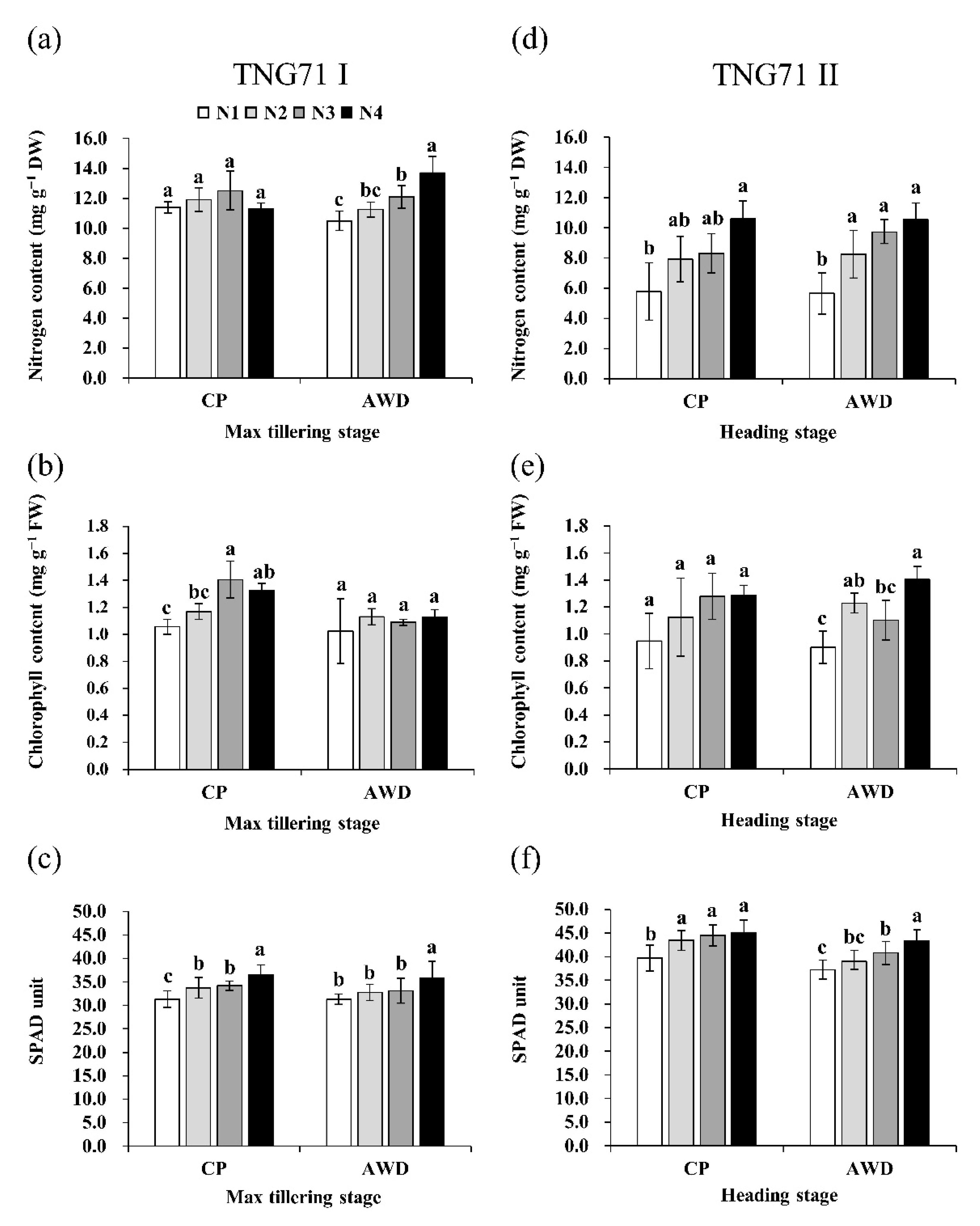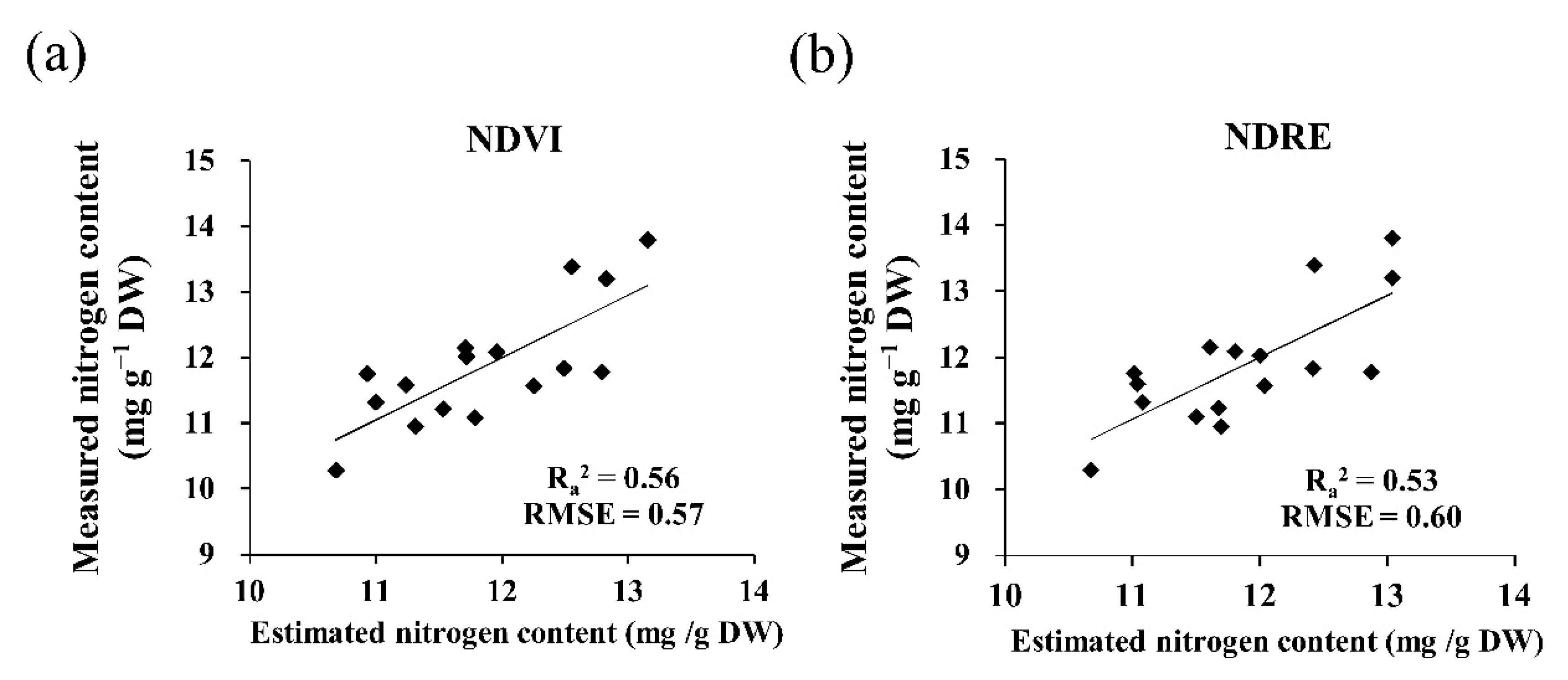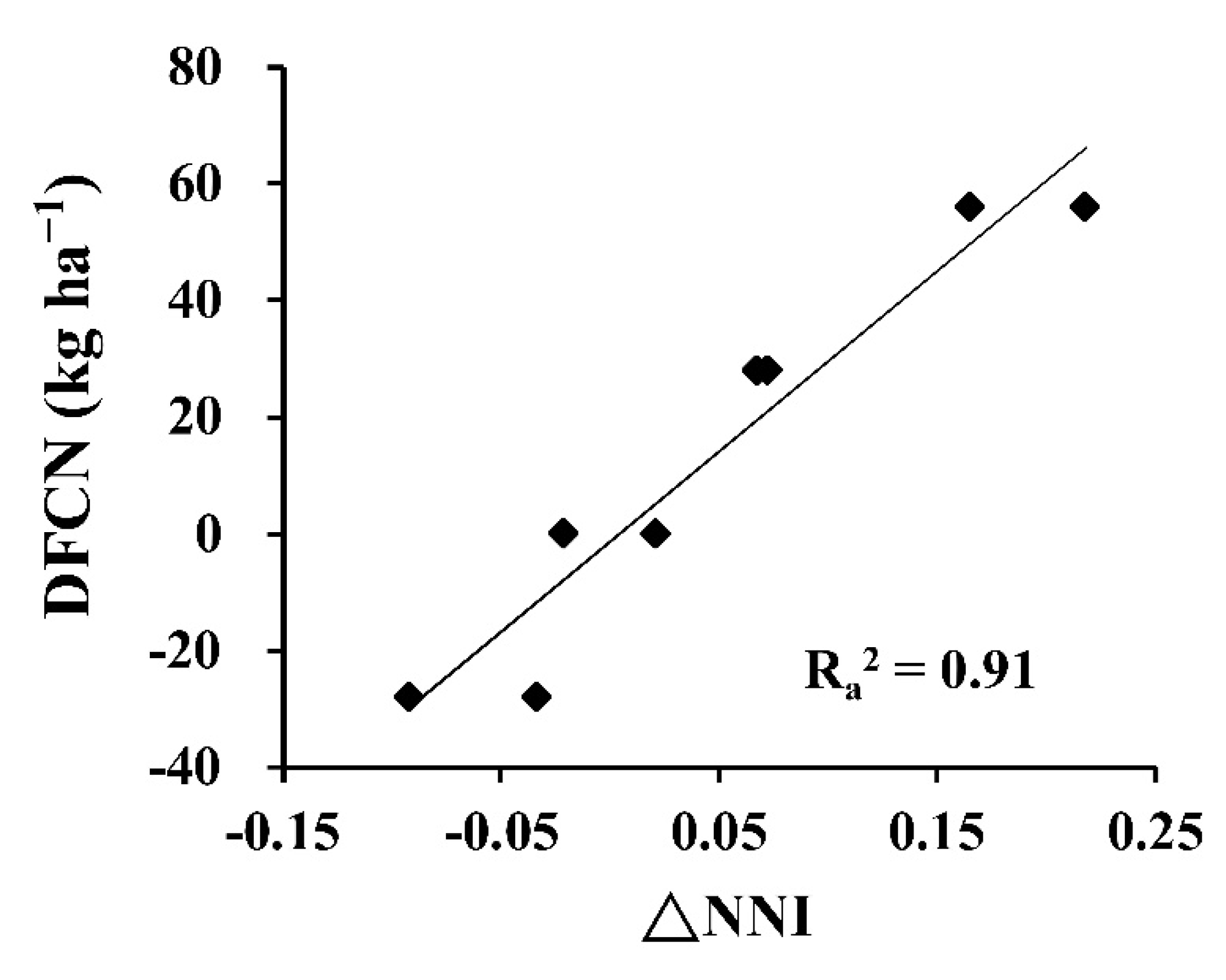Prediction of Plant Nutrition State of Rice under Water-Saving Cultivation and Panicle Fertilization Application Decision Making
Abstract
:1. Introduction
2. Materials and Methods
2.1. Experiment Location and Materials
2.2. Intelligent Water Management, Water Level Measurement, and Irrigation Water Calculation in the Experimental Field
2.3. Fertilizer Management in the Experimental Field
2.4. Measurement of Leaf Chlorophyll Content and Plant Nitrogen Content
2.5. UAV Photography and Vegetation Index Image Analysis
2.6. Statistical Analysis
3. Results
3.1. Physiological Trait Changes of Early-Maturing Rice TNG71 under Different Water and Nitrogen Fertilizer Management Conditions
3.2. Correlation Analysis and Regression Analysis of the Vegetation Indices and Fertilizer Management Indices of UAV Images
3.3. Nitrogen Fertilizer Model under AWD Irrigation of Early-Maturing Rice TNG71
4. Discussion
Supplementary Materials
Author Contributions
Funding
Institutional Review Board Statement
Informed Consent Statement
Data Availability Statement
Acknowledgments
Conflicts of Interest
References
- Premanandh, J. Factors affecting food security and contribution of modern technologies in food sustainability. J. Sci. Food Agric. 2011, 91, 2707–2714. [Google Scholar] [CrossRef] [PubMed]
- Long, S.P.; Marshall-Colon, A.; Zhu, X.G. Meeting the global food demand of the future by engineering crop photosynthesis and yield potential. Cell 2015, 161, 56–66. [Google Scholar] [CrossRef] [Green Version]
- Tito, R.; Vasconcelos, H.L.; Feeley, K.J. Global climate change increases risk of crop yield losses and food insecurity in the tropical Andes. Glob. Chang. Biol. 2018, 24, e592–e602. [Google Scholar] [CrossRef] [PubMed]
- Cai, Y.; Bandara, J.S.; Newth, D. A framework for integrated assessment of food production economics in South Asia under climate change. Environ. Modell. Softw. 2016, 75, 459–497. [Google Scholar] [CrossRef]
- Panda, D.; Sarkar, R.K. Natural leaf senescence: Probed by chlorophyll fluorescence, CO2 photosynthetic rate and antioxidant enzyme activities during grain filling in different rice cultivars. Physiol. Mol. Biol. Plants 2013, 19, 43–51. [Google Scholar] [CrossRef]
- Lim, M.N.; Lee, S.E.; Yim, H.K.; Kim, J.H.; Yoon, I.S.; Hwang, Y.S. Differential anoxic expression of sugar-regulated genes reveals diverse interactions between sugar and anaerobic signaling systems in rice. Mol. Cells 2013, 36, 169–176. [Google Scholar] [CrossRef] [Green Version]
- Verboven, P.; Pedersen, O.; Ho, Q.T.; Nicolai, B.M.; Colmer, T.D. The mechanism of improved aeration due to gas films on leaves of submerged rice. Plant Cell Environ. 2014, 37, 2433–2452. [Google Scholar] [CrossRef] [Green Version]
- Khan, A.A.; Ijaz, M.; Muhammad, J.; Goheer, A.R.; Akbar, G.; Adnan, M. Climate change implications for wheat crop in Dera Ismail Khan district of Khyber Pakhtunkhwa. Pak. J. Meteorol. 2016, 13, 17–27. [Google Scholar]
- Tuong, T.P.; Bouman, B.A.M. Rice production in water scare environments. In Water Productivity in Agriculture: Limits and Opportunities for Improvement; Kjine, J.W., Barker, R., Molden, D., Eds.; CABI: Wallingford, UK, 2003; pp. 53–67. [Google Scholar]
- Mekonnen, M.M.; Hoekstra, A.Y. Four billion people facing severe water scarcity. Sci. Adv. 2016, 2, e1500323. [Google Scholar] [CrossRef] [PubMed] [Green Version]
- Lin, L.; Zhang, Z.B.; Janssen, M.; Lennartz, B. Infiltration properties of paddy fields under intermittent irrigation. Paddy Water Environ. 2014, 12, 17–24. [Google Scholar] [CrossRef]
- Tan, X.; Shao, D.; Liu, H. Simulating soil water regime in lowland paddy fields under different water managements using HYDRUS-1D. Agric. Water Manag. 2014, 132, 69–78. [Google Scholar] [CrossRef]
- Shao, G.; Cui, J.; Lu, B.; Brian, B.J.; Ding, J.; She, D. Impacts of controlled irrigation and drainage on the yield and physiological attributes of rice. Agric. Water Manag. 2015, 149, 156–165. [Google Scholar] [CrossRef]
- Chen, Z.; Yang, X.; Song, W.; Khan, A.; Najeeb, U.; Li, P.; Cao, C. Water-saving cultivation plus super rice hybrid genotype improves water productivity and yield. Agron. J. 2020, 112, 1764–1777. [Google Scholar] [CrossRef]
- Yang, S.; Cheng, B.; Wu, J.; Shen, W.; Cheng, S. Review and prospects on rice breeding and extension in China. Rice Sci. 2006, 13, 1–8. [Google Scholar]
- Miao, Y.; Stewart, B.A.; Zhang, F. Long-term experiments for sustainable nutrient management in China. A review. Agron. Sustain. Dev. 2011, 31, 397–414. [Google Scholar] [CrossRef] [Green Version]
- Li, Y.; Šimůnek, J.; Wang, S.; Yuan, J.; Zhang, W. Modeling of soil water regime and water balance in a transplanted rice field experiment with reduced irrigation. Water 2017, 9, 248. [Google Scholar] [CrossRef] [Green Version]
- Cassman, K.G.; Dobermann, A.; Cruz, P.C.S.; Gines, G.C.; Samson, M.I.; Descalsota, J.P.; Alcantara, J.M.; Dizon, M.A.; Olk, D.C. Soil organic matter and the indigenous nitrogen supply of intensive irrigated rice systems in the tropics. Plant Soil 1996, 182, 267–278. [Google Scholar] [CrossRef]
- Cao, Q.; Miao, Y.; Feng, G.; Gao, X.; Liu, B.; Liu, Y.; Li, F.; Khosla, R.; Mulla, D.J.; Zhang, F. Improving nitrogen use efficiency with minimal environmental risks using an active canopy sensor in a wheat-maize cropping system. Field Crop. Res. 2017, 214, 365–372. [Google Scholar] [CrossRef]
- Wang, Y.; Lu, J.; Ren, T.; Hussain, S.; Guo, C.; Wang, S.; Cong, R.; Li, X. Effects of nitrogen and tiller type on grain yield and physiological responses in rice. AoB Plants 2017, 9, plx012. [Google Scholar] [CrossRef] [PubMed]
- Bendig, J.; Bolten, A.; Bennertz, S.; Broscheit, J.; Eichfuss, S.; Bareth, G. Estimating biomass of barley using crop surface models (CSMs) derived from UAV-based RGB imaging. Remote Sens. 2014, 6, 10395–10412. [Google Scholar] [CrossRef] [Green Version]
- Ju, C.; Son, H. Multiple UAV systems for agricultural applications: Control, implementation, and evaluation. Electronics 2018, 7, 162. [Google Scholar] [CrossRef] [Green Version]
- Wang, H.; Qian, X.; Zhang, L.; Xu, S.; Li, H. A method of high throughput monitoring crop physiology using chlorophyll fluorescence and multispectral imaging. Front. Plant Sci. 2018, 9, 407. [Google Scholar] [CrossRef] [Green Version]
- Osco, L.P.; Junior, J.M.; Ramos, A.P.M.; Furuya, D.E.G.; Santana, D.C.; Teodoro, L.P.R.; Gonçalves, W.N.; Baio, F.H.R.; Pistori, H.; Junior, C.A.S.; et al. Leaf nitrogen concentration and plant height prediction for maize using UAV-based multispectral imagery and machine learning techniques. Remote Sens. 2020, 12, 3237. [Google Scholar] [CrossRef]
- Ranđelović, P.; Đorđević, V.; Milić, S.; Balešević-Tubić, S.; Petrović, K.; Miladinović, J.; Đukić, V. Prediction of soybean plant density using a machine learning model and vegetation indices extracted from RGB images taken with a UAV. Agronomy 2020, 10, 1108. [Google Scholar] [CrossRef]
- Huang, S.C.; Lin, Y.C.; Liu, K.F.; Chen, C.T. Microplate method for plant total nitrogen and phosphorus analysis. Taiwan. J. Agric. Chem. Food Sci. 2011, 49, 19–25. [Google Scholar]
- R Core Team. R: A Language and Environment for Statistical Computing; R Foundation for Statistical Computing: Vienna, Austria, 2014; Available online: https://www.R-project.org/ (accessed on June 2020).
- Wei, T.; Simko, V. R Package “Corrplot”: Visualization of a Correlation Matrix (Version 0.84). 2017. Available online: https://github.com/taiyun/corrplot (accessed on June 2020).
- Ookawa, T.; Naruoka, Y.; Sayama, A.; Hirasawa, T. Cytokinin effects on ribulose-1, 5-bisphosphate carboxylase/oxygenase and nitrogen partitioning in rice during ripening. Crop Sci. 2004, 44, 2107–2115. [Google Scholar] [CrossRef]
- Cao, X.; Zhong, C.; Sajid, H.; Zhu, L.; Zhang, J.; Wu, L.; Jin, Q. Effects of watering regime and nitrogen application rate on the photosynthetic parameters, physiological characteristics, and agronomic traits of rice. Acta Physiol. Plant. 2017, 39, 135. [Google Scholar] [CrossRef]
- Yuan, Z.; Ata-Ul-Karim, S.T.; Cao, Q.; Lu, Z.; Cao, W.; Zhu, Y.; Liu, X. Indicators for diagnosing nitrogen status of rice based on chlorophyll meter readings. Field Crop. Res. 2016, 185, 12–20. [Google Scholar] [CrossRef]
- Zhong, C.; Cao, X.; Hu, J.; Zhu, L.; Zhang, J.; Huang, J.; Jin, Q. Nitrogen metabolism in adaptation of photosynthesis to water stress in rice grown under different nitrogen levels. Front. Plant Sci. 2017, 8, 1079. [Google Scholar] [CrossRef] [PubMed] [Green Version]
- Wang, Z.; Zhang, W.; Beebout, S.S.; Zhang, H.; Liu, L.; Yang, J.; Zhang, J. Grain yield, water and nitrogen use efficiencies of rice as influenced by irrigation regimes and their interaction with nitrogen rates. Field Crop. Res. 2016, 193, 54–69. [Google Scholar] [CrossRef]
- Feng, H.; Chen, G.; Xiong, L.; Liu, Q.; Yang, W. Accurate digitization of the chlorophyll distribution of individual rice leaves using hyperspectral imaging and an integrated image analysis pipeline. Front. Plant Sci. 2017, 8, 1238. [Google Scholar] [CrossRef] [PubMed] [Green Version]
- Kergoat, L.; Lafont, S.; Arneth, A.; Le Dantec, V.; Saugier, B. Nitrogen controls plant canopy light-use efficiency in temperate and boreal ecosystems. J. Geophys. Res. Biogeo. 2008, 113, 1–19. [Google Scholar] [CrossRef] [Green Version]
- Lebourgeois, V.; Bégué, A.; Labbé, S.; Houlès, M.; Martiné, J.F. A light-weight multi-spectral aerial imaging system for nitrogen crop monitoring. Preci. Agric. 2012, 13, 525–541. [Google Scholar] [CrossRef]
- Xue, L.; Cao, W.; Luo, W.; Dai, T.; Zhu, Y. Monitoring leaf nitrogen status in rice with canopy spectral reflectance. Agrono. J. 2004, 96, 135–142. [Google Scholar] [CrossRef]
- Zheng, H.; Cheng, T.; Li, D.; Zhou, X.; Yao, X.; Tian, Y.; Cao, W.; Zhu, Y. Evaluation of RGB, color-infrared and multispectral images acquired from unmanned aerial systems for the estimation of nitrogen accumulation in rice. Remote Sens. 2018, 10, 824. [Google Scholar] [CrossRef] [Green Version]





| Source | Degrees of Freedom | Mean Square | ||
|---|---|---|---|---|
| Nitrogen Content | Chlorophyll Content | SPAD Unit | ||
| Replicate | 1 | 0.6943 | 0.0014 | 15.470 |
| Water | 1 | 0.0029 | 0.0838 | 0.4834 |
| Error (a) | 1 | 0.0051 | 0.0001 | 4.8169 |
| Nitrogen fertilizer | 3 | 1.8743 * | 0.0346 * | 17.533 * |
| interaction | 3 | 1.7081 * | 0.0267 * | 0.3568 |
| Error (b) | 6 | 0.2278 | 0.0051 | 2.1829 |
| Source | Degrees of Freedom | Mean Square | ||
|---|---|---|---|---|
| Nitrogen Content | Chlorophyll Content | SPAD Unit | ||
| Replicate | 1 | 9.6395 | 0.0330 | 0.2668 |
| Water | 1 | 0.8803 | 0.0012 | 33.5415 |
| Error (a) | 1 | 0.2179 | 0.0110 | 2.1258 |
| Nitrogen fertilizer | 3 | 17.665 ** | 0.1214 * | 25.267 *** |
| interaction | 3 | 0.9428 | 0.0342 | 1.1858 |
| Error (b) | 6 | 0.9397 | 0.0207 | 1.0171 |
| Growth Stage | Nitrogen Content | Chlorophyll Content | SPAD Unit | ||||
|---|---|---|---|---|---|---|---|
| NDVI y | NDRE | NDVI | NDRE | NDVI | NDRE | ||
| I w | Seedling | 0.2810 z | - | −0.3608 | - | 0.2971 | - |
| Tillering I x | 0.3374 | −0.3991 | 0.4518 ** | 0.3583 | 0.3234 | −0.3371 | |
| Tillering II | 0.7504 ** | 0.7722 ** | 0.5949 ** | 0.6885 ** | 0.6195 ** | 0.5900 ** | |
| Max tillering | 0.8294 ** | 0.8153 ** | 0.4500 ** | 0.4828 ** | 0.6805 ** | 0.6691 ** | |
| Booting | 0.8005 ** | 0.8242 ** | 0.3039 | 0.2855 | 0.3582 | 0.3445 | |
| Heading | 0.7053 ** | 0.7786 ** | 0.5007 ** | 0.6198 ** | 0.6991 ** | 0.6355 ** | |
| Filling | 0.5151 ** | 0.5758 ** | 0.7945 ** | 0.7888 ** | 0.7614 ** | 0.7754 ** | |
| II | Initial tillering | 0.3655 | 0.3222 | −0.3638 | −0.3568 | 0.3850 | 0.5126 ** |
| Tillering | 0.5047 ** | 0.4515 ** | 0.2850 | 0.3901 | 0.4251 ** | 0.6036 ** | |
| Max tillering | −0.4315 ** | −0.3300 | 0.4798** | 0.6041 ** | 0.2702 | 0.4081 ** | |
| Heading | 0.4905 ** | 0.7051 ** | 0.1399 | 0.7747 ** | 0.2747 | 0.5483 ** | |
| Filling I | 0.3845 | 0.6302 ** | 0.3270 | 0.6449 ** | 0.2833 | 0.5511 ** | |
| Filling II | 0.5894 ** | 0.2698 | 0.8517 ** | 0.8766 ** | 0.7423 ** | 0.7864 ** | |
| Growth Stage | Nitrogen Content | Chlorophyll Content | SPAD Unit | ||||
|---|---|---|---|---|---|---|---|
| NDVI y | NDRE | NDVI | NDRE | NDVI | NDRE | ||
| I w | Seedling | 0.0132 z | - | 0.0680 | - | 0.0232 | - |
| Tillering I x | 0.0496 | 0.0992 | 0.1471 | 0.0661 | 0.0406 | 0.0503 | |
| Tillering II | 0.5318 | 0.5671 | 0.3068 | 0.4364 | 0.3389 | 0.3014 | |
| Max tillering | 0.6668 | 0.6418 | 0.1439 | 0.1762 | 0.4246 | 0.4080 | |
| Booting | 0.5071 | 0.5470 | 0.0276 | 0.0159 | 0.0660 | 0.0556 | |
| Heading | 0.4611 | 0.5781 | 0.1372 | 0.2629 | 0.4914 | 0.4025 | |
| Filling | 0.2128 | 0.2839 | 0.6049 | 0.5938 | 0.5498 | 0.5728 | |
| II | Initial tillering | 0.0564 | 0.0383 | 0.0575 | 0.0162 | 0.0883 | 0.1744 |
| Tillering | 0.1969 | 0.1318 | 0.0100 | 0.1128 | 0.1349 | 0.3084 | |
| Max tillering | 0.1233 | 0.0348 | 0.2177 | 0.3111 | 0.0070 | 0.1016 | |
| Heading | 0.3812 | 0.5928 | 0.3025 | 0.4415 | 0.0139 | 0.2469 | |
| Filling I | 0.0869 | 0.3541 | 0.0431 | 0.3742 | 0.0095 | 0.3577 | |
| Filling II | 0.2972 | 0.3235 | 0.7068 | 0.7535 | 0.5191 | 0.5913 | |
Publisher’s Note: MDPI stays neutral with regard to jurisdictional claims in published maps and institutional affiliations. |
© 2021 by the authors. Licensee MDPI, Basel, Switzerland. This article is an open access article distributed under the terms and conditions of the Creative Commons Attribution (CC BY) license (https://creativecommons.org/licenses/by/4.0/).
Share and Cite
Li, G.-S.; Wu, D.-H.; Su, Y.-C.; Kuo, B.-J.; Yang, M.-D.; Lai, M.-H.; Lu, H.-Y.; Yang, C.-Y. Prediction of Plant Nutrition State of Rice under Water-Saving Cultivation and Panicle Fertilization Application Decision Making. Agronomy 2021, 11, 1626. https://doi.org/10.3390/agronomy11081626
Li G-S, Wu D-H, Su Y-C, Kuo B-J, Yang M-D, Lai M-H, Lu H-Y, Yang C-Y. Prediction of Plant Nutrition State of Rice under Water-Saving Cultivation and Panicle Fertilization Application Decision Making. Agronomy. 2021; 11(8):1626. https://doi.org/10.3390/agronomy11081626
Chicago/Turabian StyleLi, Guan-Sin, Dong-Hong Wu, Yuan-Chih Su, Bo-Jein Kuo, Ming-Der Yang, Ming-Hsin Lai, Hsiu-Ying Lu, and Chin-Ying Yang. 2021. "Prediction of Plant Nutrition State of Rice under Water-Saving Cultivation and Panicle Fertilization Application Decision Making" Agronomy 11, no. 8: 1626. https://doi.org/10.3390/agronomy11081626
APA StyleLi, G.-S., Wu, D.-H., Su, Y.-C., Kuo, B.-J., Yang, M.-D., Lai, M.-H., Lu, H.-Y., & Yang, C.-Y. (2021). Prediction of Plant Nutrition State of Rice under Water-Saving Cultivation and Panicle Fertilization Application Decision Making. Agronomy, 11(8), 1626. https://doi.org/10.3390/agronomy11081626







